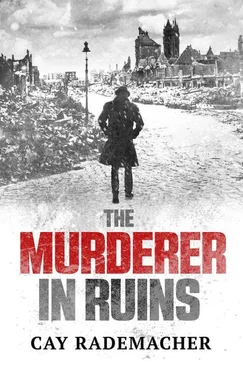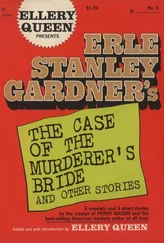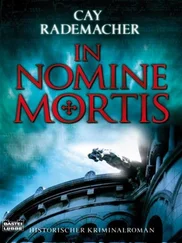Cay Rademacher - The Murderer in Ruins
Здесь есть возможность читать онлайн «Cay Rademacher - The Murderer in Ruins» весь текст электронной книги совершенно бесплатно (целиком полную версию без сокращений). В некоторых случаях можно слушать аудио, скачать через торрент в формате fb2 и присутствует краткое содержание. Год выпуска: 2015, ISBN: 2015, Издательство: Arcadia Books Limited, Жанр: Триллер, на английском языке. Описание произведения, (предисловие) а так же отзывы посетителей доступны на портале библиотеки ЛибКат.
- Название:The Murderer in Ruins
- Автор:
- Издательство:Arcadia Books Limited
- Жанр:
- Год:2015
- ISBN:9781910050750
- Рейтинг книги:5 / 5. Голосов: 1
-
Избранное:Добавить в избранное
- Отзывы:
-
Ваша оценка:
- 100
- 1
- 2
- 3
- 4
- 5
The Murderer in Ruins: краткое содержание, описание и аннотация
Предлагаем к чтению аннотацию, описание, краткое содержание или предисловие (зависит от того, что написал сам автор книги «The Murderer in Ruins»). Если вы не нашли необходимую информацию о книге — напишите в комментариях, мы постараемся отыскать её.
The Murderer in Ruins — читать онлайн бесплатно полную книгу (весь текст) целиком
Ниже представлен текст книги, разбитый по страницам. Система сохранения места последней прочитанной страницы, позволяет с удобством читать онлайн бесплатно книгу «The Murderer in Ruins», без необходимости каждый раз заново искать на чём Вы остановились. Поставьте закладку, и сможете в любой момент перейти на страницу, на которой закончили чтение.
Интервал:
Закладка:
Goddamnit, thought Stave. How come nothing fits? Every time some little detail messes up the theory. He thought back to the last autopsy. Why would a killer apparently so greedy that he even steals underclothes ignore a woman’s gold teeth? Gold would buy you anything you wanted on the black market.
Was he just stripping them to cover his tracks? But if he wasn’t killing them to rob them, if he didn’t rape them, if he had no family grudge against them, why on earth did he kill them in the first place?
Stave was so angry he could have bashed his head against the wall. Angry with the murderer, but even more so with himself, and with his colleagues who weren’t helping, and who were either obsessed with their own private dramas, or even sabotaging his efforts.
By now it was gone 6 p.m. The anteroom was empty, the corridor was deserted. Right, thought Stave, if I can’t get anywhere with the main task, maybe I should investigate the other one. The private one.
He left his room and went quietly along the dimly lit corridor, glancing cautiously in the other offices where the doors were open. It was a quiet evening. Stave reached the stairwell, went down two floors and stopped. Up until that point, anybody who might have seen him would have thought he was just going home. But from here on he was in foreign territory. The chief inspector took a deep breath and entered the realm of the vice squad.
There was a corridor with offices on either side, just like upstairs in the homicide department. There were no lights on anywhere. Stave hurried down the corridor in the dark, taking stock of the nameplates on the doors.
Police Inspector Lothar Maschke.
He glanced around, then tried the door handle.
Not locked.
Stave slipped through the door silently and closed it behind him. His heart was pounding. He had never done anything forbidden in all his life, and yet here he was, breaking into a colleague’s office.
He took his torch from his pocket, turned it on and looked round. There was no anteroom, just one tiny office. It looked messy, piles of reports and police mug shots, notebooks, empty Lucky Strike packets all over the desk. An overflowing ashtray. A chair carelessly pushed back from the desk rather than neatly tucked in. On the wall, held up with four rusty tacks at a bit of an angle, was a map of Hamburg with the places where the bodies were found marked with pencil crosses. On another wall was Maschke’s police academy diploma. That wasn’t straight either.
Stave walked over to the desk, taking care not to touch anything. A framed photo of a serious-looking elderly woman. The chief inspector recalled that his colleague still lived at home with his mother. Apart from that there was nothing personal. Just the pile of stuff on the desk, copies of the missing person posters, the autopsy reports, the police photographs, lists of surgeons and dentists.
But not the missing files.
Stave pulled on thin black leather gloves, then began sorting through the paper, taking care to leave it exactly as it had been. You never knew if the mess might be deliberate.
Nothing.
The desk drawers next. There were two on either side. Top left: cigarettes, lighters. Stave raised his eyebrows. A lot of them for somebody on a police salary. Either his colleague sent half his pay literally up in smoke or he had sources a detective ought not to.
The lower drawer was deep and contained index cards with photos. Stave pulled one out and studied it. It showed police mug shots, with names next to them. Notes on the other side, in Maschke’s handwriting.
‘Street name: Lena or the Dane.’
‘Carries knife on each ankle.’
‘Willy Warncke’s girl (Fat Willy).’
‘Yvonne Delluc. Has family here.’
‘Note: Isabelle is favourite with British officers. Don’t go hard on her.’
‘Arrested 5.1.47 black marketing, one pair nylon stockings, 20 cigarettes.’
The chief inspector flicked through the pile. Whores. Pimps. Whores. Pimps. No punters. Astonishing how many of his targets Maschke had categorised in his brief time with the vice squad.
The index cards were in no recognisable order, but Stave reckoned Maschke would know where each was. There’s definitely some sort of order in this apparent chaos, he thought to himself.
Right upper drawer: pencils, a broken sharpener, notebooks with pages torn out. There were one or two that were full but that Maschke clearly intended to use again. Next to them a couple of rubbers and two bent paperclips, a few rusty tacks and flakes of tobacco.
Lower right drawer as deep as that on the left: a dozen or so scraps of paper, mostly scrunched up, another three notebooks. Stave shone the pale milk beam from his torch in and glanced over the scraps of paper. Columns of figures. The pieces of paper were covered in scribbled numbers. Sometimes there were just a few on one sheet, sometimes there were lots. The notebooks were also stuffed with numbers. Telephone numbers? Safe combinations? There was nothing to give a clue as to what they meant. No names, not even a single letter.
Beneath the sheets of paper was a current Reichsbahn train timetable for all the occupation zones – not much use this winter when nobody had any idea when, or if, a train might depart.
Below that were topographical maps, the sort they had handed out in the Wehrmacht, large scale – Northern Germany, Lower Saxony, Denmark, the Netherlands, Belgium and Luxembourg, France, Bavaria and Austria, Switzerland.
Stave stared in amazement at the neatly folded maps. Obviously the area round Hamburg was of interest to a detective, but foreign countries? He drew up a map in his head: all the countries to the north, west and south of the old Reich borders. Maschke had been in the Wehrmacht, on the western front. But why had he kept all these maps? Why had a U-boat sailor even had them? Stave went through them again. They seemed pristine, except for the one of France. The lines along the folds were white. There were tears around the edges. He took it out and spread it carefully on the piled-high desk. The map covered all of France, and was the size of the desk.
There were pencil marks here and there, military signs, letters and numbers, probably abbreviations for units. Dates next to them. Several of the marks had been erased and written over, or sometimes just crossed out and something else scribbled in.
It painted the picture of a retreat.
The oldest note was from 1 June 1944, almost on the Atlantic coast to the north of Bordeaux. Then there was a line that went north to Normandy. The Allied invasion, Stave thought to himself. Then the line fell back to the east. The last entry was near Strasbourg, towards the end of November 1944.
As the chief inspector was folding the map up again, the beam fell on a faded official Reich stamp on the rear: an eagle and a swastika, with a few scribbles beneath. Stave was just about to put the map back with the others when he suddenly froze: in the midst of the stamp was writing, the double runes of the SS.
And underneath, barely legible, a name: ‘Hans Herthge.’ In Maschke’s handwriting.
Stave was wondering what it might mean when he heard a noise in the corridor outside.
Footsteps.
The chief inspector had just seconds to think. Whoever it was would almost certainly walk straight past. But what if they didn’t? What if they found him in here with a torch peering into the desk drawers of one of his colleagues? Should he hide? But where?
Brazen it out. He closed the drawer, turned off the torch, shoved the map of France and his leather gloves into his overcoat pocket and turned on the desk reading light. If somebody spotted him, then he would act as if he had nothing to hide.
The footsteps got louder, then stopped. Somebody was standing right outside the door. Stave bent his head over the desk as if he was looking for something.
Читать дальшеИнтервал:
Закладка:
Похожие книги на «The Murderer in Ruins»
Представляем Вашему вниманию похожие книги на «The Murderer in Ruins» списком для выбора. Мы отобрали схожую по названию и смыслу литературу в надежде предоставить читателям больше вариантов отыскать новые, интересные, ещё непрочитанные произведения.
Обсуждение, отзывы о книге «The Murderer in Ruins» и просто собственные мнения читателей. Оставьте ваши комментарии, напишите, что Вы думаете о произведении, его смысле или главных героях. Укажите что конкретно понравилось, а что нет, и почему Вы так считаете.











